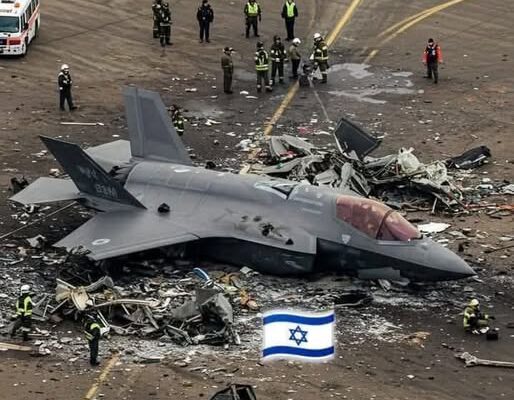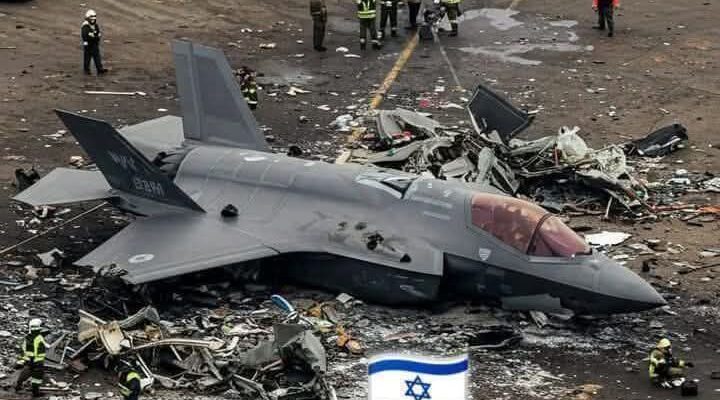
This image shows a dramatic scene of a military aircraft crash, with numerous emergency personnel and responders surrounding the wreckage on what appears to be a tarmac or runway. The focal point is a downed stealth fighter jet—an F-35 Lightning II, marked with visible damage and debris scattered all around it. Based on the roundel and insignia, the aircraft appears to belong to the Israeli Air Force, further emphasized by the digitally added Israeli flag placed in the foreground of the image.
Aircraft Overview
The fighter jet in question is an F-35, identifiable by its distinctive angular shape, stealth design, and low-profile structure. The F-35 is a fifth-generation multirole combat aircraft developed by Lockheed Martin and used by numerous air forces around the world, including Israel’s. These jets are capable of ground attack, aerial reconnaissance, and air defense missions. The visible markings on the tail—especially the stylized Hebrew letters and the tail code—reinforce its Israeli affiliation.
Despite its reputation for advanced avionics, stealth capabilities, and high performance, the aircraft in the image has suffered a catastrophic incident. The damage is extensive, although the central body and cockpit seem largely intact. This suggests the crash might have happened at low altitude or during landing, rather than in mid-air, where the consequences might have been far worse.
Scene Description
The scene is chaotic yet controlled. Emergency responders, including firefighters, paramedics, and military personnel, are dispersed throughout the crash site. They are dressed in high-visibility uniforms, helmets, and gear appropriate for emergency aviation response. A white-and-orange ambulance is parked on the left side of the image, ready to transport any casualties.
The tarmac is scorched, and broken pieces of fuselage, engine parts, and other wreckage litter the area around the jet. Scattered debris indicates that the aircraft might have collided with other objects during the incident or shed parts upon impact. The ground bears signs of intense heat, impact friction, and potential secondary explosions, as suggested by charred patches and the volume of shattered components.
Although the cockpit canopy remains closed, the presence of multiple emergency crews close to the aircraft implies that the pilot may have either ejected before impact or survived with assistance. No visible smoke or fire suggests the blaze has already been extinguished or that the crash didn’t result in an explosion.
Emotional and Strategic Implications
From a strategic point of view, the crash of an F-35 is significant. These aircraft are among the most expensive and advanced in the world, valued at tens of millions of dollars each. For Israel, one of the first countries outside the U.S. to operate the F-35 in combat missions, the loss of one jet is not only a financial blow but also a potential hit to operational capabilities or even intelligence security if sensitive technologies are compromised.
Emotionally, the photo evokes a deep sense of gravity. The quiet stillness of the jet, contrasting with the movement of responders and the destroyed surroundings, serves as a reminder of the fine line between cutting-edge technology and human vulnerability. The presence of the Israeli flag might be symbolic, suggesting resilience or national pride despite the disaster.
Symbolism and Broader Interpretation
The Israeli flag placed prominently in the foreground introduces a symbolic narrative—possibly added digitally to emphasize national identity or evoke patriotism in light of the loss. The blue Star of David framed by white and blue stripes stands out against the gray, burnt backdrop, offering a stark juxtaposition of peace and tragedy, resilience and ruin.
In broader terms, this photo captures a rare and sobering moment: a modern marvel of engineering brought to rest under tragic circumstances. It reflects not only the dangers of military aviation but also the stakes involved when operating high-performance combat technology. There’s a story of high risk, precision, and vulnerability embedded in the image—a reminder that even the most powerful machines are not immune to failure.
Technical Observations
- Aircraft Damage: The jet’s right wing appears damaged or missing part of its structural integrity. The area surrounding the nose and undercarriage is heavily affected. Landing gear may have collapsed or failed, judging by the aircraft’s low position and impact pattern.
- Debris Field: The debris seems to include metallic panels, twisted wiring, and parts of either other equipment or the same jet, suggesting a violent crash. This could be from failed landing attempts or secondary collisions with ground structures.
- Runway Condition: The surface of the tarmac shows tire marks, fluid stains (possibly fuel or hydraulic), and shrapnel patterns. A yellow taxiway line bends near the impact site, marking the aircraft’s potential trajectory during or before the crash.
- Safety Response: The presence of responders with fire-resistant gear indicates protocol was followed efficiently. The lack of visible panic shows a calm, coordinated effort likely from a trained airbase or military facility.
Conclusion
This photo encapsulates a significant and unsettling event in aviation and military terms: the crash of a highly advanced Israeli F-35 jet. The combination of advanced machinery, human skill, and the unpredictable nature of flight is dramatically illustrated in this scene. Surrounded by professionals, overseen by medics, and marked by national symbolism, the image stands as a powerful representation of risk, responsibility, and the enduring presence of national pride even amid destruction.
Whether analyzed for technical details, emotional weight, or symbolic meaning, this single frame offers a multi-layered glimpse into the aftermath of modern aerial warfare and the human efforts that follow in its wake.





